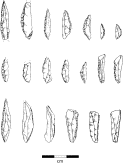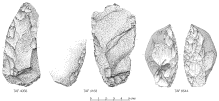R.N.E. Barton, A. Bouzouggar, J.T. Hogue, S. Lee, S.N. Collcutt, P. Ditchfield
Source - http://www.sciencedirect.com/science/article/pii/S0047248413001383
Journal of Human Evolution
Abstract
Recent genetic studies based on the distribution of mtDNA of haplogroup U6 have led to subtly different theories regarding the arrival of modern human populations in North Africa. One proposes that groups of the proto-U6 lineage spread from the Near East to North Africa around 40–45 ka (thousands of years ago), followed by some degree of regional continuity. Another envisages a westward human migration from the Near East, followed by further demographic expansion at ∼22 ka centred on the Maghreb and associated with a microlithic bladelet culture known as the Iberomaurusian. In evaluating these theories, we report on the results of new work on the Middle (MSA) and Later Stone (LSA) Age deposits at Taforalt Cave in Morocco. We present 54 AMS radiocarbon dates on bone and charcoals from a sequence of late MSA and LSA occupation levels of the cave. Using Bayesian modelling we show that an MSA non-Levallois flake industry was present until ∼24.5 ka Cal BP (calibrated years before present), followed by a gap in occupation and the subsequent appearance of an LSA Iberomaurusian industry from at least 21,160 Cal BP. The new dating offers fresh light on theories of continuity versus replacement of populations as presented by the genetic evidence. We examine the implications of these data for interpreting the first appearance of the LSA in the Maghreb and providing comparisons with other dated early blade and bladelet industries in North Africa.

Figure 1. Distribution of Iberomaurusian sites. 1. Cap Rhir, 2. El Khenzira, 3. Contrebandiers, 4. El Harhoura II, 5. Dar es-Soltan I, 6. Ghar Cahal, 7. Kehf El Hammar, 8. Hattab II, 9. Ifri El Baroud, 10. Ifri n'Ammar, 11. Kifan Bel Ghomari, 12. Taforalt, 13. La Mouillah, 14. Rachgoun, 15. Columnata, 16. Cap Ténès, 17. Rolland, 18. Rassel, 19. Oued Kerma, 20. El Hamel, 21. El-Onçor, 22. Afalou Bou Rhummel, 23. Tamar Hat, 24. Taza, 25. Ouchtata localities, 26. Horizon Collignon.

Figure 3. Main section on the south side of the cave (Sector 8) showing the Grey Series overlying the Yellow Series. Scale is 2 m long. (Photo: Ian Cartwright; copyright: Institute of Archaeology).

Figure 5. Three phases of the Iberomaurusian. Top row: IB3 Curve-backed and elongated straight-backed bladelets; Middle: IB2 curve-backed points and ‘La Mouillah points’ (right); Bottom: IB1 Backed point (far left), Ouchtata bladelets (second and third from right), and obtuse-ended backed bladelets. Scale in cm. (Drawings by J.T Hogue).

Figure 6. Non-Levallois flake industry at Taforalt. Side scrapers (TAF 4056 in quartzite and TAF 6544 in chert), retouched flake (Taf 4163 in quartzite). Scale in cm. (Drawings by M. Grenet).